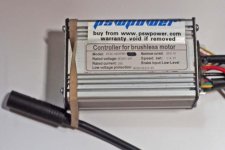ScooterMan101
1 MW
Who has used a higher voltage than 52 volts ( 58 volts hot off the charger ) on the Little Q100 motor and display ?
I already know that when I go up to 16s or even 18s that I will have to lower the amps to 15 / 16 amps max , that is not a problem , I will program the controller or have someone program if for me.
The
Potential Problem is ... Will the/ my Display work with those higher voltages ?
I bought the S-LCD3 Display , on website it says voltage fits for 24 volt or 36 volt or 48 volt . Reference MK00005 ( I am currently using 14s batteries and it reads the voltage when I charge to 58 volts )
But
BMS also lists a S-LCD3 Display that is 72 volt . Reference MK00006 , Is this the same Display ? or the Same Display with some adjustments on the programing to allow reading of voltages up to 72 volts ?
Or in other words , is there something I can do to make my MK00005 Display work up to 20s battery packs ?
I already know that when I go up to 16s or even 18s that I will have to lower the amps to 15 / 16 amps max , that is not a problem , I will program the controller or have someone program if for me.
The
Potential Problem is ... Will the/ my Display work with those higher voltages ?
I bought the S-LCD3 Display , on website it says voltage fits for 24 volt or 36 volt or 48 volt . Reference MK00005 ( I am currently using 14s batteries and it reads the voltage when I charge to 58 volts )
But
BMS also lists a S-LCD3 Display that is 72 volt . Reference MK00006 , Is this the same Display ? or the Same Display with some adjustments on the programing to allow reading of voltages up to 72 volts ?
Or in other words , is there something I can do to make my MK00005 Display work up to 20s battery packs ?


